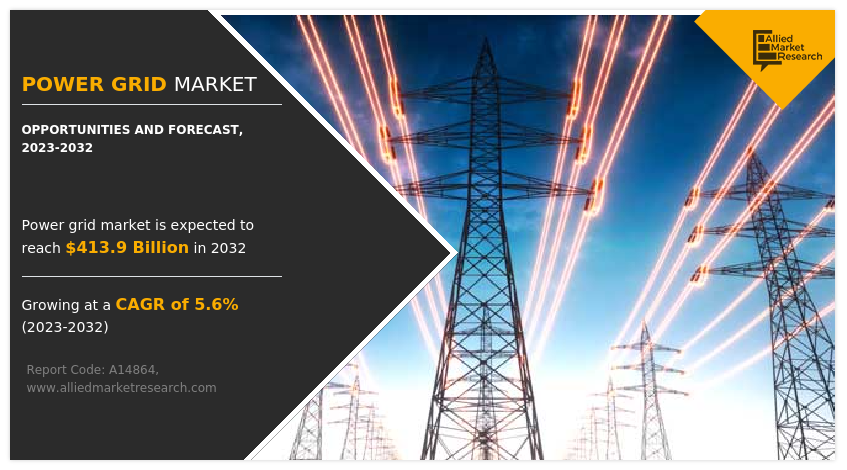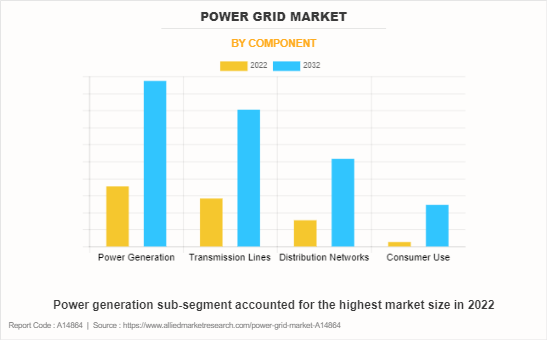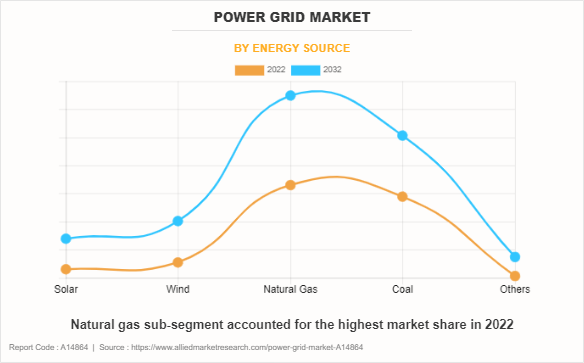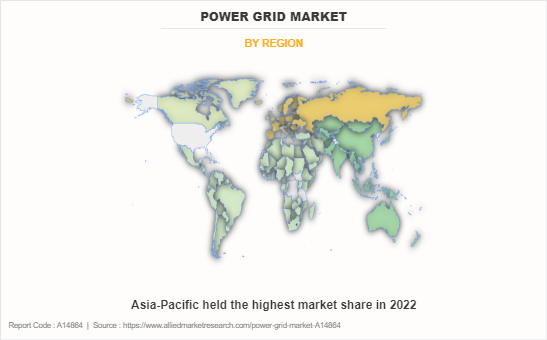Power Grid Market Research, 2032
The global power grid market size was valued at $241.6 billion in 2022, and is projected to reach $413.9 billion by 2032, growing at a CAGR of 5.6% from 2023 to 2032. The power grid is a sophisticated network of power lines and associated infrastructure that serves as the backbone of the modern electrical system. It plays a pivotal role in transmitting and distributing electricity from power plants to homes and businesses across vast geographic areas. This intricate web of power generation, transmission, and delivery ensures a seamless supply of electrical power. The power grid encompasses generator stations, transmission lines, towers, and individual distribution lines that collectively power various sectors such as consumer electronics, electric vehicles, aviation, renewable energy storage, manufacturing, industrial, commercial, residential, and others. Thus, the power grid plays a vital role in electricity generation, distribution, and transmission across several applications.

Power grid plays a major role in boosting industrialization and globalization. This is because power grid is the primary means by which electricity is delivered to industrial facilities. As the industrial sectors and manufacturing units heavily rely on a consistent and abundant supply of electrical power for their operations, a power grid is necessary as it provides energy required for different operations. In addition, the availability of a reliable and extensive power grid encourages the establishment and growth of industries. Efficient power grids, supports the development of infrastructures such as factories, production facilities, commercial spaces, and others. Furthermore, rising energy consumption, enhanced grid stability, and increasing demand for energy efficiency are major factors leading to a positive impact on the power grid market demand. For instance, increasing urbanization, industrialization, and population growth contribute to a higher demand for electricity. An efficient power grid is essential to meet the rising energy needs of various sectors. In addition, the global shift towards renewable energy sources, such as solar and wind, requires a more flexible and intelligent grid. Efficient grids can seamlessly integrate renewable energy, manage fluctuations, and enhance overall sustainability.
Also, as the concerns over climate change are intensifying globally, there is a greater emphasis on reducing greenhouse gas emissions. Thus, an efficient power grid that supports the integration of cleaner energy sources has gained significant popularity in recent years. Furthermore, as several businesses are increasingly focusing on energy efficiency to reduce costs and environmental impact, the demand for efficient power that optimizes electricity transmission with reduced energy losses is increasing. These are the key aspects projected to drive the power grid demand in the upcoming years.
High transmission losses and dependence on specific energy sources such as coal, natural gas, and others are anticipated to restrain the power grid market expansion in the upcoming years. For instance, the transmission and distribution of electricity over long distances can result in energy losses due to resistance in power lines. These transmission losses can reduce the overall efficiency of the power grid. In addition, the majority of the power grids rely heavily on coal or natural gas. This dependence can make the grid vulnerable to fluctuations in fuel prices, supply disruptions, and changes in energy policy.
The technological advancements in power grid with the integration of automation, robotics, and artificial intelligence (AI), are estimated to boost the efficiency of power grid on a global scale and drive the power grid market opportunities in the coming years. For instance, the smart grid which is a modern grid facilitates two-way flow of electricity between power utilities and consumers. These modern grids are equipped with digital technologies such as automation, connectivity, and communication. For instance, the smart grids have advanced metering infrastructure (AMI) and advanced demand forecasting in which analytical methods and techniques are used to determine the futuristic power demand based on historic & current power utilization that helps in achieving energy efficiency and managing the energy expenditures. In addition, the integration of big data into smart power grids offers efficiency, asset utilization, stability, and system reliability that helps in gaining the customer satisfaction.
The key players profiled in this report include Siemens AG, ABB Ltd, General Electric Company, Schneider Electric SE, State Grid Corporation of China, Eaton Corporation, Mitsubishi Electric Corporation, Toshiba Corporation, National Grid plc, and NextEra Energy, Inc. Investment and partnership are common strategies followed by major market players. For instance, in November 2023, Siemens Smart Infrastructure announced the partnership with Copperleaf, the analytics solution provider for infrastructure companies. This partnership will help Siemens in optimizing the investments and technical grid planning. Also, this partnership will lead to cost savings and improved reliability of power.
The power grid market is segmented on the basis of component, energy source, and region. By component, the market is divided into power generation, transmission lines, distribution networks, and consumer use. By energy source, the market is classified into solar, wind, natural gas, coal, and others. By region, the market is analyzed across North America, Europe, Asia-Pacific, and LAMEA.
The power grid market is segmented into Component and Energy Source.

By component, the power generation sub-segment dominated the market in 2022. Power generation is a fundamental and essential component of the power grid infrastructure. This is because power generation helps in meeting the increasing energy demands of societies, industries, and economies. For instance, as populations grow, urbanize, and adopt modern technologies, the demand for electricity rises, making power generation an indispensable aspect of the power grid. In addition, power generation supports economic activities by providing the necessary energy for industries, manufacturing, commercial enterprises, and services. In addition, the availability of diverse energy sources such as wind, solar, and others has boosted the popularity of power generation in the recent years.

By energy source, the natural gas sub-segment dominated the global power grid market share in 2022. The popularity of natural gas as an energy source is attributed to its versatility, reliability, and ease of availability. For instance, natural gas is a versatile fuel source that is widely used for electricity generation. This is because natural gas offers flexibility for the power plants to adjust their output quickly, providing stability to the power grid and supporting the integration of variable renewable energy sources. Also, natural gas is a reliable and readily available energy source.
In addition, the existing infrastructure for natural gas extraction, transportation, and distribution makes it a convenient option for power generation, ensuring a stable and continuous energy supply. The use of natural gas as an energy source has lower greenhouse gas emissions compared to coal and other fossil fuels. Thus, natural gas offers environmental sustainability and helps in reducing the carbon footprint during electricity generation via power grid.

By region, Asia-Pacific dominated the global market in 2022. Growing demand for reliable power and growing investments in renewable energy projects is anticipated to have s positive impact on the Asia-Pacific power grid market statistics. Asia-Pacific countries have shown a remarkable shift in the renewable energy landscape with significant investments in the renewable energy sector. For instance, in Asia-Pacific, investments in the renewable energy sector are estimated to reach $1.3 trillion in next 10 years. For instance, Vietnam received $27.2 billion in total foreign direct investment (FDI) in 2022. In this investment, around $5.5 billion was allocated to renewable energy, with investors favoring projects in the solar and wind power industries.
Also, Thailand has emerged as a largely onshore hub for operational renewable energy projects. Similarly, Japan is undergoing diversification in renewable investment fund flows in recent years. In Singapore, the government’s commitment toward green finance and sustainable development via solar panel deployment initiative SolarNova and the Sustainable Singapore Blueprint, has led to significant investments in the renewable energy projects.
Impact of COVID-19 on the Global Power Grid Industry
- The COVID-19 pandemic had widespread and varied impacts on electricity generation via power globally. The fluctuations in energy demand was majorly influenced by factors such as the severity of the pandemic in different regions, government responses, changes in energy demand patterns, and others.
- For instance, the industrial shutdowns, reduced commercial activities, and increased remote working, led to reduced electricity demand in certain sectors, while residential demand, particularly for home offices, increased.
- In addition, many industries scaled back or temporarily shut down operations during the pandemic. This resulted in reduced electricity consumption by industrial and commercial sectors. Reduced energy demand was majorly seen in the manufacturing, hospitality, and aviation sectors.
- The supply chain disruptions, travel restrictions, and financial uncertainties reduced the investments in renewable energy projects, installation, and commissioning. All these factors negatively impacted electricity generation, its demand, transmission, and distribution that takes place via power grid.
Key Benefits For Stakeholders
- The report provides exclusive and comprehensive analysis of the global power grid market trends along with the power grid market forecast.
- The report elucidates the power grid market opportunity along with key drivers, and restraints of the market. It is a compilation of detailed information, inputs from industry participants and industry experts across the value chain, and quantitative and qualitative assessment by industry analysts.
- Porter’s five forces analysis helps analyze the potential of the buyers & suppliers and the competitive scenario of the market for strategy building.
- The report entailing the power grid market analysis maps the qualitative sway of various industry factors on market segments as well as geographies.
- The data in this report aims on market dynamics, trends, and developments affecting the power grid market growth.
Power Grid Market Report Highlights
| Aspects | Details |
| Market Size By 2032 | USD 413.9 billion |
| Growth Rate | CAGR of 5.6% |
| Forecast period | 2022 - 2032 |
| Report Pages | 320 |
| By Component |
|
| By Energy Source |
|
| By Region |
|
| Key Market Players | State Grid Corporation of China, Toshiba Corporation, ABB Ltd., NextEra Energy, Inc., Schneider Electric SE, Eaton Corporation, Mitsubishi Electric Corporation, National Grid plc, Siemens AG, General Electric Company |
The growing popularity of renewable energy integration and smart grid technologies that focus on the launch of flexible and robust power grid solutions, advanced metering infrastructure, and grid management systems are the major drivers that are anticipated to generate excellent opportunities in the upcoming years.
The major growth strategies adopted by the power grid market players are partnership, investment, and technological advancements.
The electrification in the transportation sector that has boosted the global electric vehicle sales globally is anticipated to drive the adoption of power grid in the upcoming years.
Asia-Pacific is projected to provide more business opportunities for the global power grid market in the future.
Siemens AG, ABB Ltd, General Electric Company, Schneider Electric SE, State Grid Corporation of China, Eaton Corporation, Mitsubishi Electric Corporation, Toshiba Corporation, National Grid plc, and NextEra Energy, Inc. are the major players in the power grid market.
The industrial and commercial sectors, renewable energy developers, utility & energy sector, and electric vehicle charging infrastructure providers are the major customers in the global power grid market.
The report provides an extensive qualitative and quantitative analysis of the current trends and future estimations of the global power grid market from 2022 to 2032 to determine the prevailing opportunities.
The power generation sub-segment of the component acquired the maximum share of the global power grid market in 2022.
The power grid market has benefited from technological advancements in recent years. Smart grids, and decentralized energy systems have enhanced the power grid which is anticipated to influence the power grid market in the upcoming years.
Loading Table Of Content...
Loading Research Methodology...


